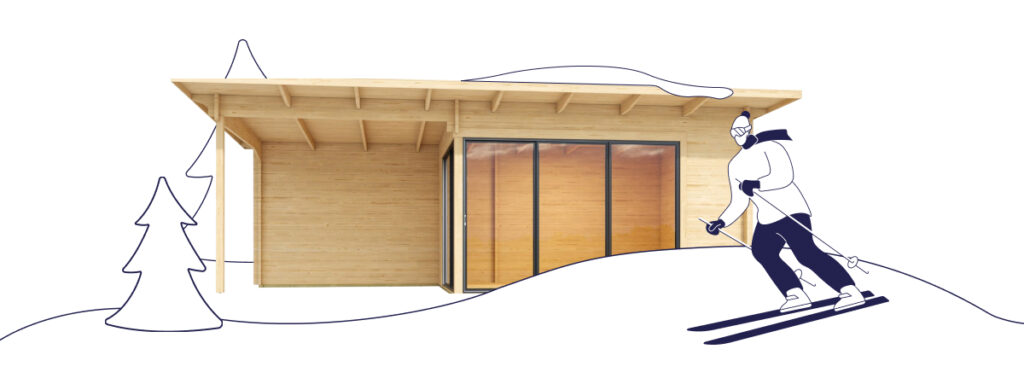How to Prep Your Backyard Shed for Winter
 back to all articles
back to all articles
Every homeowner knows how useful the backyard shed is all year round, it helps you eliminate clutter and organize your yard, as well as shelter all your tools and equipment from environmental factors.
However, that’s not all a garden shed is good for.
A garden shed can be utilized as a green room for pots and plants if you are passionate about gardening.
They can also act as an outdoor emotional escape room, to get away from the stresses of everyday life or an outdoor working space, to keep your home and work life separate.
There are endless possibilities when it comes to the different uses of garden sheds, but regardless of how you choose to use yours, it is a crucial part of any home.
Therefore, it is important to properly maintain your garden shed and prepare it for different weather conditions all year round.
The winter is known for its festivities and magical atmosphere, but it also comes with some serious weather challenges to protect your home, your garage, and your garden shed as well.
So, in this post, we are going to cover how to prepare your garden shed against harsh weather conditions during the winter.

Clean The Shed Out
The first step in prepping your garden shed for the winter is to clean it properly.
All you have to do is clear everything you have in your shed outside and then start going through the different items to decide which ones you need to keep and which items you have no use for anymore.
This step is taken not just for the sake of organization and efficiency. The purpose of clearing your shed is to enable you to properly check for any holes or cracks in the structure of your shed.
You can even use a water hose to clean the interior of the shed from dust and debris that may block your eyes from catching any holes in the floor or walls.
This is a crucial step, because without it, all your winter preparation will be useless if your garden shed structure is full of vulnerabilities, that will leave all your items exposed to the weather conditions.
Get Organized
After you are done clearing all the items in your shed and checking for any cracks and holes, it is time to organize everything you chose to keep in the garden shed.
Try to make use of every inch of space available, while keeping everything neat. The first step in organizing any garden shed is prioritizing the most valuable and frequently used items to be more easily accessed, even during the winter.
Another great way to help you organize your shed is by using hooks or shelves to hang and store different items and tools. You can even add hooks to the backdoor of the shed to maximize your storage and space.
Also, you can store smaller items in mason jars or drawers to avoid having your garden shed fall back into chaos once again, due to small items being randomly placed all around the shed.
Necessary Maintenance
Now that your shed is all neat and tidy with everything back in place, it is time to do all the necessary maintenance your shed needs, that you have been delaying all year.
Start by repairing any cracks or holes that you found earlier while cleaning your shed and replace any wood panels if needed. Next, check your roof and make sure there aren’t any gaps or broken tiles.
Following this, make sure you check your shed for any mold. In case you do find any traces of mold, make sure to remove it with bleach or any other cleaner before it spreads.
Additionally, make sure to apply wood treatment to all the exposed wood panels to protect it against humidity, rain, or snow.
Also, if you have any metal equipment make sure to coat it with a little oil to prevent it from rusting in your shed during the winter.
Every homeowner knows how useful the backyard shed is all year round, it helps you eliminate clutter and organize your yard, as… Continue reading How to Prep Your Backyard Shed for Winter

Use a Tarp
As we have already covered, sheds are vulnerable against humidity and water. Wood is a strong material, but can quickly weaken when continuously exposed to water ,and it can even cause mold to grow and spread through the entire garden shed.
Hence, it is always good practice to use a tarp to cover the exterior of your garden shed, especially the roof which can collect snow throughout the winter.
The tarp helps shield your garden shed from rain, snow, and strong winds when hooked to the ground. For added protection, you can also use a tarp to cover expensive metal tools and any machinery you have in your garden shed.
This prevents the metal from rusting over time. In case you are unable to use a tarp to cover the exterior or roof of your shed, make sure to make up for it by properly covering all metal and vulnerable items on the inside of your shed.

Conclusion
There you have it, after following these steps your garden shed, as well as its contents will be safe and sound throughout the winter and in any harsh weather conditions. Even though the process may seem overwhelming at first glance, it is relatively simple, if you just take it one step at a time.
Also, the process gets easier when your garden shed is regularly maintained all year round. Just remember to prioritize the prepping and protection of important items in your garden shed over small and unimportant items.
The process of preparing your shed for the winter saves you both money and time over the long run. The time and energy you put into prepping your garden shed proves worthwhile when the lifespan of your tools, equipment, and shed are prolonged as a result.
So, instead of having to repair a shed after a harsh winter and replace items that were ruined as a result of being exposed to the weather, take a couple of hours to get your shed ready and you will able to use it for many years to come.
Ready to upgrade your garden
or want to get inspired?




